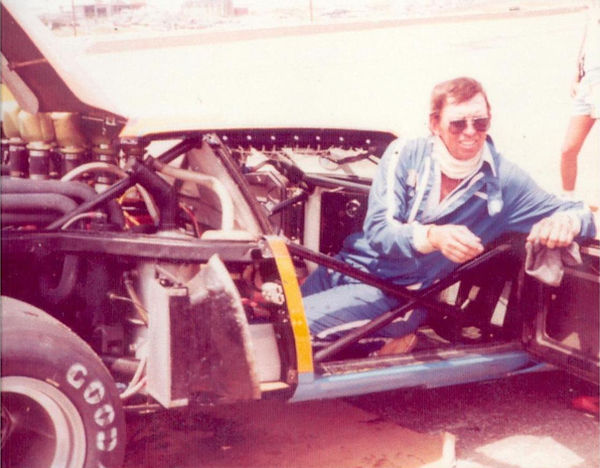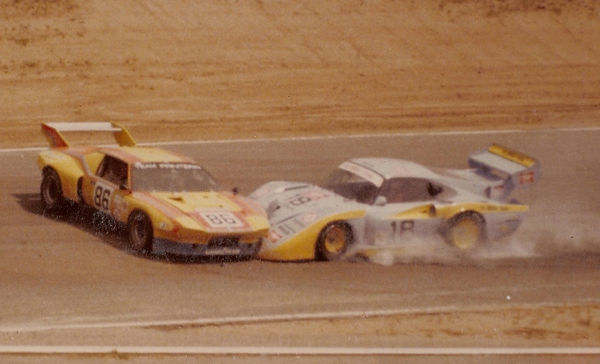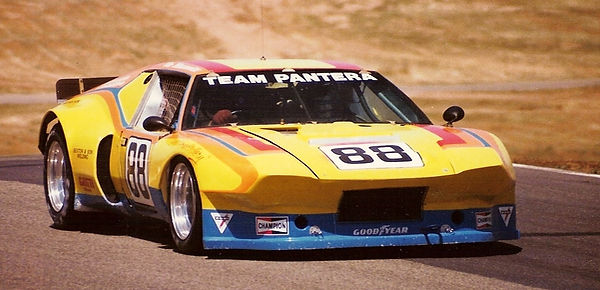Hugh Kleinpeter Gr 5 Pantera
Chassis #1603

Photo: Kurt Oblinger
Back in the USA, the Hugh Kleinpeter chassis, 1603, underwent a significant evolution during its IMSA days.
Unlike chassis 001 in Italy, Hugh's Pantera began life as a 1972 street model. But eventually became the most radical and well developed IMSA Pantera racecar in the late 70's and early 80's.
1603 was initially built to IMSA GTO specs, which for the most part followed Group 4 regulations, but even in GTO form, it surpassed the factory Group 4 efforts. Hugh is quoted in Wally Wyss' book, DeTomaso - The Man and the Machines, as saying "Whenever we came across a Group 4 or GT4 (Pantera) from Europe, we were at least 5 seconds a lap faster".
With IMSA looking for ways to break up the Porsche domination, in 1977 they created the GTX class based on Group 5 regulations. To match the new regulations, Hugh Kleinpeter continued to develop his Pantera noting, "Towards the end, we had a complete space frame for the car with the fiberglass body just cladding it."

Photo: Matt Stone
The picture above shows the fuel injected engine and some of the original main chassis structures remaining. Later, following a crash at Riverside Raceway, the chassis was further modified with a full custom fabricated tubular sub-frame.
Attesting to the effectiveness of the team's design and development, Hugh's "Team Pantera" captured the USRCC (United States Road Racing Championship) National Championship for the SCCA Southeastern Division in 1978 with three consecutive wins.
There is a nice account of the history of Hugh Kleinpeter's Pantera in Alexis Gousseau's IMSA History blog

Photo: Credit Needed
As shown above, 1603 was modified for right-hand drive to optimize weight distribution; completely backward for most of us here in the USA ... and, based on this photo, may have caused some confusion for American drivers on the proper entry approach and seating position ;-) ....
(Actually, that's Rod Davis pictured above working on the car.)
Removable composite front and rear body sections also reduced weight and allowed rapid access to the mechanical and chassis systems as needed in a racing environment.
Later purchased by Vic Manuelli, Vic and his "Fantasy Racing" team captured the 1981 SCCA Division A-Sport Racing Championship title after beating a Ferrari 512 Boxer at the final race of the season.

At Riverside International Raceway
Photo: Credit Needed

The much modified Pantera continued to evolve from 1981 through 1984, racing in the Group 5 and IMSA GTX eras, eventually racing under the IMSA GTP and GTO classifications up through 1984. While classified as a GTP car, this Pantera was competing against not just the Porsche 935s, but also Lola T-600s and March 82g prototypes!
1603 was co-driven in (3) of the IMSA events with Bruce Mallery - the 1981 & 1982 Times Grand Prix at Riverside, and the 1984 G.I. Joe's Grand Prix at Portland. At the 1982 Riverside International Raceway event Bruce was "T-boned" in turn 5 by the John Paul Jr. driven JLP Porsche 935.
Photo: Matt Stone
Capturing that moment, the photo above was run in full-color on the front page of the Orange County Register newspaper. A picture of the Pantera before the crash was also published in the Los Angeles Times. As some say: "all press is good press", and this was probably the first and last time a race Pantera got as much publicity in a major US newspaper!

Photo: Vic Manuelli
Pictured above in its final IMSA GTO spec at Riverside Raceway in 1985 where the team was in testing/practice in anticipation of entering the Times Grand Prix. Unfortunately an engine failure ended those plans. 1603 was eventually sold to another private party, but it's days of professional racing were over.
Unlike chassis 001, which adopted a major change in the body design with its eventual entry into the prototype class, 1603 always kept the identifiable styling of a Pantera.
